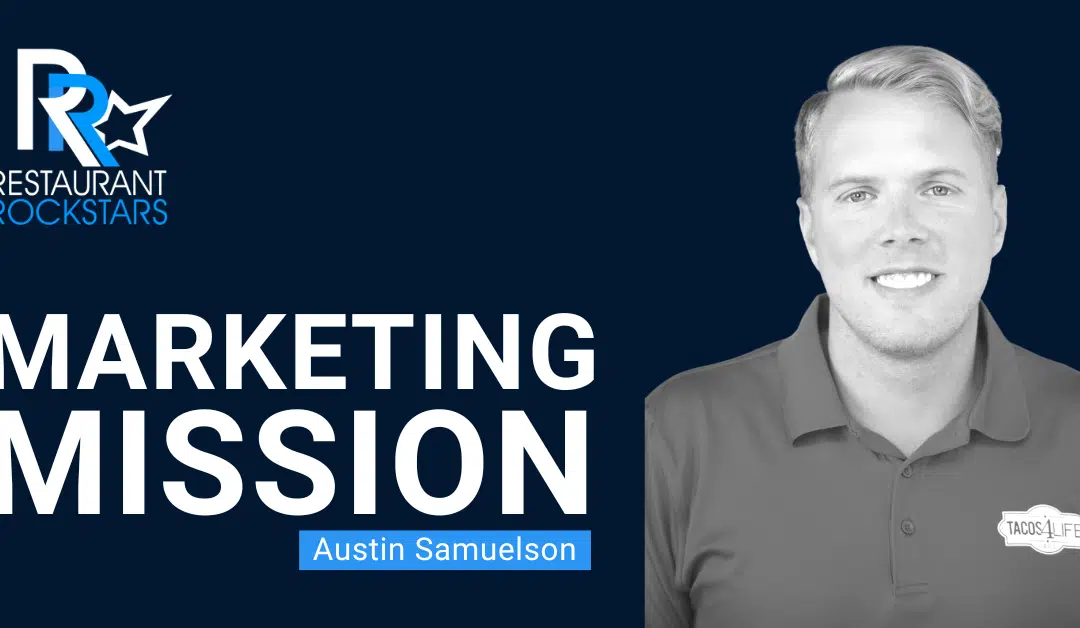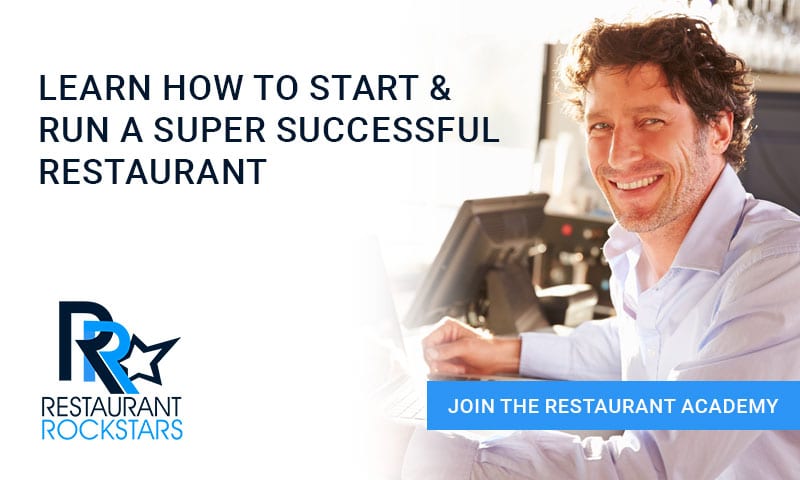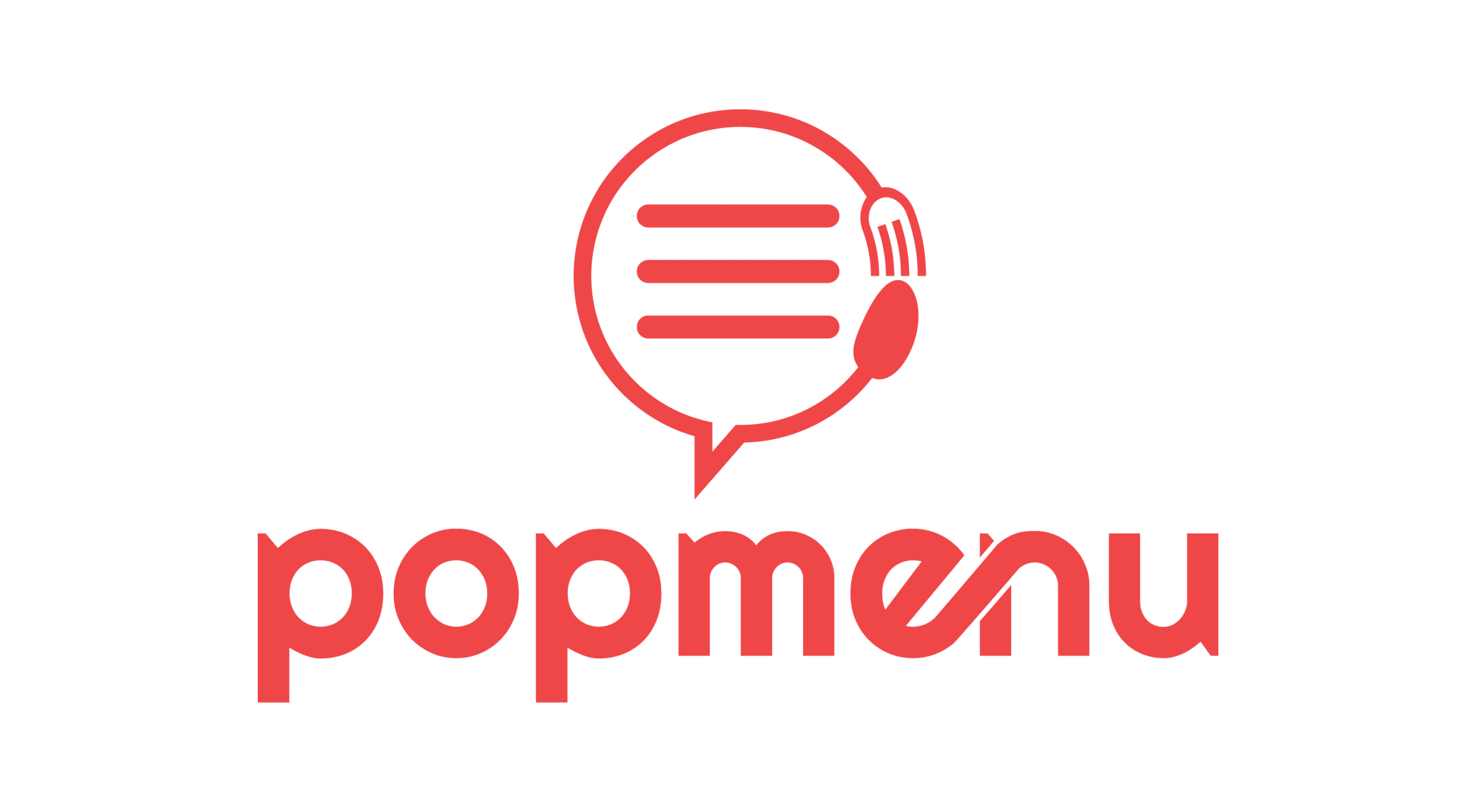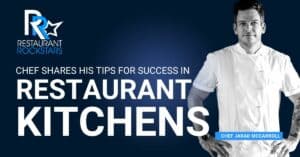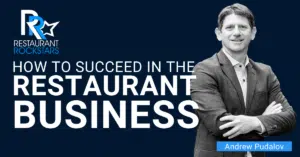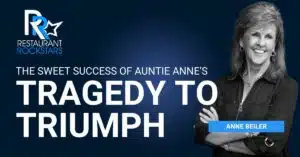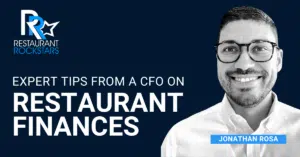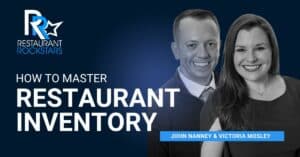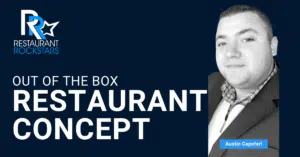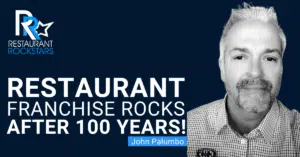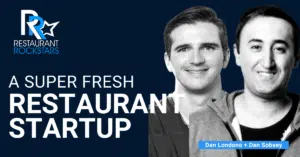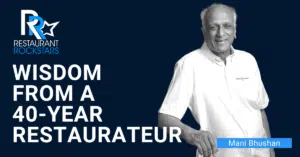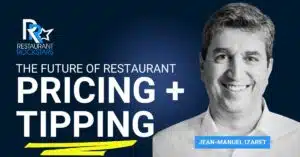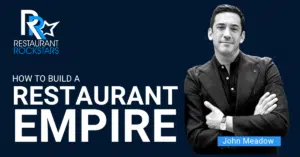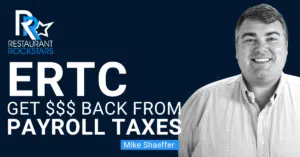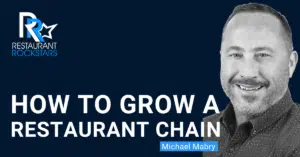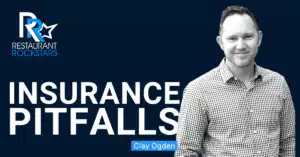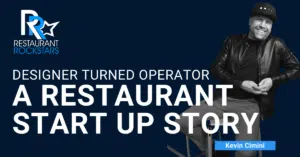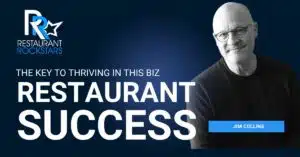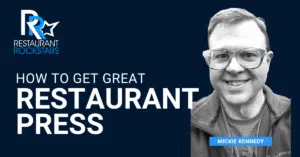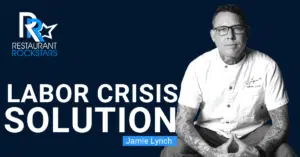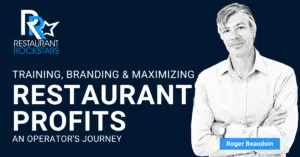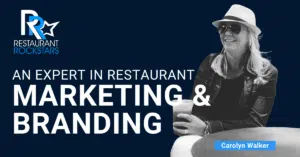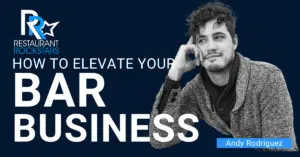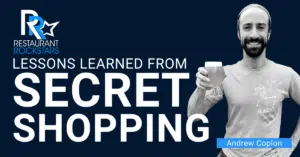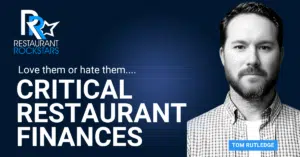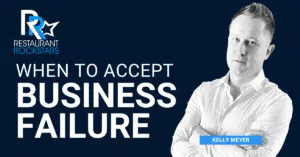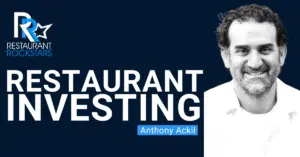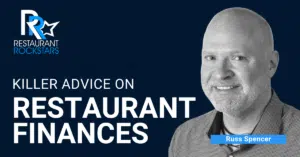Restaurant Rockstars Episode #306
Restaurant Marketing With A Mission
LISTEN HERE OR ON YOUR FAVORITE PODCAST PLAYER
Prefer to watch the interview?
Click the video below.
Not every first restaurant succeeds.
Many of us have opened concepts with the best of ideas and intentions only to see the dream fade.
Those who see a more powerful future vision and keep going may rise to extraordinary heights.
In this episode of the Restaurant Rockstars Podcast, I speak with Austin Samuelson of Tacos 4 Life.
Austin and his wife started their first concept by trying to make a healthier pizza. It wasn’t the success they hoped for, but that did not deter them from realizing a much bigger mission.
As 25 million children die from starvation worldwide each year, the Samuelson’s are making a huge difference one meal at a time.
The pair crowdfunded their next concept from about 350 people, with a truly one-for-one model—for every taco, salad, quesadilla, rice bowl, or nachos sold, 24 cents is donated to Feed My Starving Children, which is the equivalent of one meal.
Since opening, Tacos 4 Life restaurants have collectively donated more than 19 million meals. When you buy a meal, you feed a child in need.
Listen on as Austin shares:
– The Tacos 4 Life start-up story and how they grew to 21 locations
– Branding and ambiance as a competitive advantage
– Catering as a profitable brand extension
– Their unique way of staffing, onboarding, and training during the labor crisis
– Marketing that works
And of course, how great food and service give back to the world at large.
Don’t miss this inspiring episode. Go Rock YOUR Restaurant!
Roger
Connect with our guest:
Guest 0:00
He said 18,000 Kids are gonna die to die from starvation. And I’m a numbers person that just spoke to me and it really kind of changed the whole trajectory of ash and I’s life. That’s when TOMS shoes was really popular. You know, having never worked in a restaurant before I thought, man, if if a shoe company can donate, you know, do this one from one day, why can’t a restaurant do that
Roger Beaudoin 0:20
today’s guest is the co founder of a 21 location fast growing chain, whose mission is to end world hunger. So doing good by doing good is their main operating philosophy. Can’t wait to introduce this guest to you. In addition to that, we’ll be talking all about the vibe and what makes a really powerful brand that continues to grow in addition to operating challenges that we all face each day. Stay with us.
Roger Beaudoin 0:47
You’re tuned in to the restaurant rockstars podcast, powerful ideas to rock your restaurant, here’s your host, Roger Beaudoin.
Roger Beaudoin 1:03
rockstars your team are the foundation of your business and every shift, they’re leaving impressions with your guests in your restaurant. Now every impression counts and they have to be positive. Training is the key and absolutely essential to providing what I call amazing dining experiences. But effective training takes time and commitment if you had to do it yourself. Well, imagine a staff training tool that’s completely customized to your restaurant, brand, and restaurant. It teaches your entire menu and what makes your restaurant brand special. Then it trains your team your entire team to sell because sales are the lifeblood of your business. Now, it’s also important to recognize rising talent in your organization. This tool also trains future stars to become leaders that can run your business for you. I call that an exit strategy. Now this tool is called SRV. Now learn more at SRVnow.com. That’s srvnow.com Check it out.
Roger Beaudoin 2:05
Not answering your phone is one of the quickest ways for your restaurant to lose a potential customer. But between serving in person customers and dealing with the kitchen. It’s hard for staff to prioritize incoming calls. That’s why your restaurant needs pop menu answering simple questions to keep your phone line tied up can be handled without pulling a staff person from your in person hospitality. Reclaim the power of your phone. Popmenu answering is powered by artificial intelligence to answer the simple questions most people call in with like do you have outdoor seating or what are your hours within the popmenu platform you can customize answers for your restaurant and choose the voice your guests here. Plus create customized greetings. Popmenu answering picks up your phone 24/7 365 days a year turning every phone call into an opportunity. Plus popmenus full collection of tools helps optimize your restaurants website and menu streamlines your ordering experience and assist in retargeting to enable you to build long lasting relationships with your guests. Get help answering your restaurants calls now with popmenu answering. And for a limited time my listeners can get $100 off their first month plus an unchanging monthly rate at popmenu.com/rockstars Go now to get $100 off your first month at pop menu.com/rockstars
Roger Beaudoin 3:30
Welcome back everyone. This is the restaurant rockstars podcast and I am particularly inspired by today’s guest Mr. Austin. Samuelsson is the co founder of a company called tacos for life. And it’s a fast growing company. But they’ve got a specific mission. And there’s so much bad going on in this world today. And just turning on the news is just so sad. And you know, Austin and his wife Ashton’s mission is really to end world hunger. So welcome to the show. Austin. I’m really glad to have you here today. Yeah, thanks for having me on.
Guest 3:59
Roger, I’m truly honored. Well, you know, we talked about this a few minutes ago. But the restaurant business, of course, is super challenging. And from what you told me, You really didn’t have any relevant restaurant experience, but you had an idea and you have a mission in mind. And I want to know all about the mission and the statistics and the problem that you see in the problem that you saw and how you’re making a difference. And really, you know, what your end goal is with tacos for life, and then we’ll talk about starting a company. Yeah, yeah, absolutely. So yeah, I think you know, your question of what, what relevant restaurant experience did you have or what brought you into this? And if you would have asked me 15 years ago, would you know, I’d be where I am today, working in this industry? I would have said No, probably not. And that’s that’s not because I didn’t want to we’d just growing up I grew up in the country and we’ve worked on on the farm and worked construction and that’s that’s what we did you know, and for. My wife’s name is Ashton for both of us. She hadn’t worked. She never worked in the restaurants either. And really, it all started because of back in 2009. We heard a statistic at that time that the the number is different now, thank goodness that at that time 18,000 children died every day from starvation and malnutrition. And you know, I’m from Arkansas at that, that point in our lives, we’re both living in Los Angeles. And, and you knew hunger was a problem, right? It’s the hunger here. Hunger is a problem here in Oregon saw a living in Los Angeles, there’s a large homeless population that we’re aware of, and we did some volunteering to serve. But for whatever reason, we heard that that statistic were at church, and the guy that was sharing that was from World Vision, and he said, 18,000 kids are gonna die to die from starvation. And I’m a numbers person. And that just, that just spoke to me. And it really kind of changed the whole trajectory of ash and I’s life. But he said two other things as well. He said, he said, You know, it’s 18,000 kids, but our planet produces enough food to feed everybody. It’s a distribution problem. And the third point that he said was, it’s really a caring problem. And he said, we’re in a church setting, okay. But he said, you know, hey, gosh, if if people had just even went to church here in America, if we would all do something about this, this could be a solved problem, you know, but it’s a matter of, do we care enough? Do we love enough? And, and that really, that really spoke to me, and it spoke to Ashton as well at the same time. And that really started our journey. We didn’t leave there thinking, hey, let’s let’s start a restaurant. It didn’t go straight into that. But over the course of a couple of years, we kept kept, we kept learning, doing research, trying to understand what was going on. And all at the same time, we just felt this tug, to do something more to be, you know, a part of trying to help the kids. And it really all kind of went to this breaking point a couple years later. And and I remember thinking, I’m like, Man, I just want to do something more. I want. I want there to be something more. And that’s when TOMS shoes was really popular.
Roger Beaudoin 7:13
Yes. They’re giving shoes away. Yeah. For every pair. Yeah,
Guest 7:19
right. Exactly. Exactly. Roger, so yeah. So So okay, so we backup and again say reiterate fact, I’ve never worked in a restaurant No, no knowledge of the industry at all, except that it’s love to eat. I do love to eat, you know, and, and, and so does Ash is phenomenal cook. But, um, you know, having never worked in a restaurant before I thought, man, if if a shoe company can donate, you know, do this one for one thing, why can’t a restaurant do that? You know, and, and that’s really where this whole journey for Ashton and I started with, with the restaurant, we share that idea with her. And she was like, Yeah, we should do that someday and do some crazy life events, we ended up opening our first restaurant is a pizza restaurant, in 2011. And with that model, we donate a meal for every meal we sold. And and then that eventually led to a start in tacos for life. And we started tacos for life and 2014. And with the whole idea that we believe we can help be a part of any starvation. So every taco salad rice bowl case to do we sell we donate a meal to feed a child.
Roger Beaudoin 8:27
That’s such a beautiful story. I mean, again, this is what mostly inspired me, I’m I’m fascinated by your business model, of course. But really, the giving back piece is, is like you said it’s not done enough. And if more people and if more companies got involved, not just in this country, but around the world, it is a very solvable problem and quicker than you might think. So that that per se is beautiful. Let me ask you a question. You mentioned a pizza restaurant, did you decide not to stay in pizza? Because it sounds like it was successful? You’re able to donate money to this cause and you decided to pivot from pizza to tacos? Because?
Guest 9:03
Well, yeah, so we learned probably, this is one of the first pieces of advice if anybody asks, and we certainly can tell you all the things not to do right having never worked in a restaurant opening one. But you know, with the pizza restaurant, it was just, it was kind of our minimal viable product, you know, what’s the lowest lowest threshold to get into so that we could start this mission? And we spent all our time, you know, clarifying how we’re going to give the mills we work with a phenomenal organization Feed My Starving Children, and just getting the restaurant built. And, you know, we went to six banks and six banks said no, and that’s a whole nother story. But I mean, we did it all by hand, you know, and, but at the end of the day, quite honestly, Roger, you know, we really tried to lean on the mission and hope that the food could kind of keep up, you know, and the reality of it, the food was okay. And that’s one of the things that we really learned some pizza for two people, you know, here in Conway is that’s where we were, we’re for to was and we’re, we’re based out of Conway, Arkansas, you know, people still come up and say, Man, I love your restaurant. I was like, you loved it, but you didn’t eat. You know. And and that was the reality. They love the mission. They love the idea of it. But they didn’t crave the food. And and ultimately, it would, it was a restaurant that didn’t make it, you know, but, but God use that in some incredible ways. And I think we always learn best from our failures, you know. And that’s what really led us into tacos for life. So let’s talk
Roger Beaudoin 10:35
about Feed My Starving Children. Now, that’s a nonprofit organization and you what’s the nature of your relationship? And how do they sort of work cohesively with you or you are just donating sales on an annual basis, a percentage of sales to obviously this, this nonprofit, or you’re you’re more deeply involved in that, I’m sure. So tell us about that.
Guest 10:56
Yeah, so we’ve been working with him since day one, since the pizza restaurant. And they’re phenomenal organization based out of Minneapolis, they work in over 70 countries around the world, and they work to distribute the scientifically formulated meal packs, okay, so it’s, it’s rice is a rice based mill with soy protein, dehydrated veggies, and a vitamin mix. And it’s really designed in such a way where if it was the only meal that a child got in a day, it would have the proper nutrients to sustain them and help for proper development, particularly for their brain, you know, because that’s such an important thing. If you’re malnourished, you know, in those early years for development, but, but they’re phenomenal, great, great organization, 90 cents on the dollar that you send them goes to feeding, you know, and they work all over the world. So our relationship with them, though, is pretty simple. We just send them all every Monday we send them, you know, a check. And for the amount of meals, so we keep track of how many tacos salads, rice bowls, case studies we sell. And, and then they get a deposit in their account of, you know, equivalent, it takes 24 cents is all it takes 24 cents to provide a mil so that’s nice. So it’s really that simple. And it’s a good meal, it tastes good, and it’s nutritious, it’s, it is so important, because in so many of these places that it’s going, we’re I mean lives are at stake. You know, if you do get a hold of something, you might just get, you know, rice, or you might get you know, corn, you know, pops in Africa. But it doesn’t have the vitamins, it doesn’t have all the protein and and all that stuff that you need to really help a child develop. And so this is it’s such a good, good meal. Feed My Starving Children is a phenomenal partner and really helped make this thing possible.
Roger Beaudoin 12:43
I’m really glad you’re sharing that. Can you also share perhaps some statistics of the results that you’ve achieved through your company, maybe on an annual basis of what giving that you’ve obviously provided to the organization and how many children you fed? Perhaps just curious, I mean, this is all relevant to me.
Guest 13:00
Well, and I’m always blown away about this, and it’s just a miracle. But yeah, we’re we’ve raised over 23 million meals now in time with tacos for life. And so we’re coming up on our eight year birthday, and it’s just absolutely incredible. And the cool thing is, you know, each restaurant we open so well, we’d like to say it this way, because with our with franchising, you know, every three restaurants provides a million meals a year, basically. Yeah, I mean, so you kind of put that in perspective, a million meals, you know, and that’s a million lives being touched, and kids and families being cared for needs being met, which is just phenomenal. So today, from what I understand, and what I’m, you know, hearing, you know, pre COVID that that number was no longer 18,000 kids that perish from starvation, the number had dropped to 6200 range is the number that you’d hear most commonly use. Still,
Roger Beaudoin 13:58
almost a third of it. Yeah.
Guest 14:00
So and of course, while we, you know, talking about life is like a pebble in the hole, you know, ocean of this, you know, good that’s going on, but it’s incredible. COVID probably is going to upset that a little bit. And of course, what’s going on Ukraine, and Russia is gonna set that with how that’s gonna affect their the wheat harvest and that sort of stuff. But that there’s a there’s a need. And that’s the thing, though, that I just, we try to tell our team members, and our guests all the time is like, Guys, this is so solvable. And it only takes 24 cents, you know,
Roger Beaudoin 14:31
well, you’re really humble guy, but I certainly wouldn’t downplay that if I said that. Or if I knew that my organization could impact a million meals, you know, just with regularity. It’s like you’re making a huge impact out there. And obviously, it’s something to be very proud of. It’s extremely noble. The cause is beautiful, because, you know, I have kids and kids are very, very important. Obviously, they’re my favorite charities, of course. Wow. So okay, that’s tremendous. Let’s shift gears a little. Let’s talk about what it was like starting your first restaurant, let’s talk about the pizza place. What challenges not knowing Okay, so you and I have a lot of similarities. My audience knows my very first business was a pizzeria. 27 years ago, I had absolutely no restaurant experience, I had an idea, crazy idea got into the business. And it’s like, I made the same mistakes that a lot of owners made. And then I started to put systems in place and figure out how to make money. But we all have the bumps in the road. And the challenge is, tell us about your journey to starting the first restaurant, what that was like, and then tell us let’s transition into tacos for life. You know, how long you were in your first store before you then started? Uh, you know, I’m also curious about company owned stores versus franchise locations. And the whole franchising process can be daunting, of course, but you’ve been through all of this. So, I mean, that’s, that’s a mouthful and a lot to talk about. But take us from the beginning and just take us through your restaurant journey. I would love to hear it.
Guest 15:54
Yeah. So, you know, we, like I said, we started with a pizza restaurant, and just had no idea where to even begin, you know, and so, we, I just picked up the phone and started calling people and, you know, just, there’s just been so many incredible people in our path. That is, that have offered advice or nuggets, and so sort of getting advice and learning here and there. And, and we went to six banks, like we talked about, and they all said no. And then the other thing, Roger, you know, we had no idea how to cook a pizza in a commercial oven. You know, and so we we bought our first pizza, and we actually bought it, we moved in with my parents. We were living in their basement, and we we bought the pizza oven and set it up down there and got a three phase converter so we can run the oven, you know, and in practice making pizzas in the basement. We smelled like pizza all the time. Ashton was teaching school and she’s teaching third graders. And a couple times a week, at least the kids that come up to him back, Miss Sam, you smell like pizza? She’s like, Yeah, I’ve been around lately. And you know that smell? Right? You’ll never get it. Oh, absolutely. It’s a very distinct does the great smell from pizza restaurant? But yeah, but yeah, so we just been, it was it was kind of one of those things where I remember we had a, we had this whiteboard, I went and bought a used whiteboard, those eight feet long. And we just wrote every every to do and it was like you eat the elephant one bite at a time. And it was just incredible how God provided along the way. And we just kept putting one foot in front of the other week, we never did get bank funding on the first one or the second one. But you know, we, we, we talked to family and friends and we got help the funding was we self funded. And then we did all the work ourselves. Like we built, we built all the booths, we did all the build out of the building, all the construction, you know, everything we could to save money and just to get it get us up off the off the ropes, and it was good. And but yeah, we bids for two, we opened in September of 2011. And we converted it to tacos fly. So it ended up being tacos for life. Number two, we made that conversion in 2015. So it would never really we never could get it profitable. And so we really struggled in. And that was a very tough decision to kind of, you know, basically face the reality of you know, we gave it our best shot. But that it wasn’t wasn’t wasn’t what the plan was.
Roger Beaudoin 18:31
It wasn’t meant to be. But you had a bigger plan in mind. It sounds like God had a bigger plan in mind for you. And then a taco thing. So where did the idea for the tacos for life come in? And the name and all of that? I mean, did you just sort of had it? I mean, obviously you’re in the south. And obviously Mexican food is popular in certain southern states. It’s popular everywhere, really. But tell us where that came from?
Guest 18:53
Oh, yeah, we love Mexican food. And we lived in California for a time mash. And I did, man, great, great Mexican food there as well. And yeah, for sure. We always joked about it. We did another restaurant concept. It has to be talking. It’s like, tacos are really our favorite, you know, food group. We felt like pizza was easier. That’s, that’s why we chose that route. You know, initially, we were very overwhelmed with trying to you know, do it all that needed to be done for tacos. And but the funny story is Roger, we it’s two different people in the same week. You know, it’s funny how people intersect their lives, right and, and say things and it’s like, oh, there might be some truth to this. But two people, friends of mine still friends. They’re still friends. Okay. They, they both told Ashton, they said, you know, we really love this mission of getting to help feed kids. And every time we buy a meal, we get to donate and we love that. That’s incredible. The only thing is if you had a different type of food, we might be able to support the mission more. So, you know, I think they’re telling us, hey, you know, we love it, but your food’s not that great, you know, and it’s two different friends unconnected you know, kind of then at the same time, and that really started at night, on this journey of thinking, okay, there’s a need, we feel like people, they want to be able to be a part of the solution. Having it in a restaurant format gives them that opportunity. Now we need to do our part in trying to figure out okay, let’s create a menu that that people will love. And that started started in 2012 2013 timeframe that’s working on that. And man, we Ashton, she, she has no culinary training or anything. But she has a phenomenal palate, amazing cook, just all self taught. But she’s also very humble. And we were really blessed. Our food provider here in Arkansas has many key foods. And they have a test kitchen, and they have a chef on staff. And we’ve just go down there once a week, and we’d spend, you know, three quarters of a day there in their kitchen was Shane and Ashton and me, and we’d just be cooking and eating and sales reps would walk in, and they’d bring stuff up from the warehouse. And it was just this collaborative experience of brainstorming, you know, Hey, what should the next menu be like, and it was such a fun thing
Roger Beaudoin 21:09
get big flavor without the labor with smoking fast from Smithfield. It’s fully cooked or smoked proteins, including American barbecue staples, and global flavors, everything from ribs to pull chicken to brisket and barbacoa. All are authentically slow cooked to perfection. It’s so delicious. Your guests will never know it wasn’t smoked right in your own kitchen. Now you can add barbecue to your menu without adding a pitmaster to your payroll, visit Smithfieldculinary.com.
Guest 21:40
But that’s, that’s really what what led us and really it was kind of all on this basis of like, okay, we got the mission, let’s create, each menu item needs to have this craveable factor to it, you know this, you take a bite and you can’t wait for that next bite you finished eating with us and you can’t wait for the next time that you get to eat with us again. So that’s really where the the inspiration for tacos for life came from. Was that,
Roger Beaudoin 22:05
that’s fantastic. All right, let’s keep this going. So how long Well, obviously you learn from your mistakes and learn, obviously, what you needed to do to put the framework in place and then initial systems to get tacos for life off the ground. And now that’s work that has worked much better. And then you started to expand tell us, you know how long it took before you started to expand to other locations? And then where did the franchising thing come in?
Guest 22:30
Yeah, so a little bit like what you mentioned, Roger, I’m a Systems guy like systems I like I like the thought of, you know, building out structure. And, you know, I remember reading the E Myth back in the very early days of the pizza restaurant, and it was like, this is this is me, this is exactly and so I never was the the technician, you know, of like, I just want to be in the restaurant, just getting lost. And that’s Ashton. She’s Ashton is really the restaurant tour. I mean, she’s, she’s phenomenal, loves, the team loves the guests. I love all those things, too. But I mean, she could spend every single day there and just be totally fulfilled. I like to build and I like process and structure. And so in the back of my mind, that was part of part of my thinking with this was, if God gives us the opportunity, you know, we land on something that people like, and there’s an opportunity to grow, I want to be set up to try to grow. And so we I remember, the first day we opened the taco restaurant dogs for life, and, and at the end of the day, we closed and we had done more business than we ever imagined doing. And there’s a line out the door the whole day, it was raining. And I remember looking at Ashton and our manager, and I was like, Okay, we’re gonna open a second one of these. And we immediately started work on on location, ended up being location number three in Fayetteville, Arkansas. But, but that was, that was kind of that moment, we, we raised, I don’t want to I need to go look up the exact number, but it was like 1100 mils that we write in that first day. And I remember at the pizza restaurant, it was like 200 mils were raised in a day, you know, to kind of put that in. And so it’s like, okay, hey, we can raise a whole lot more meals be I think there’s something that the guests wants here and then see, I think there’s a viable business that we have. And so we really, we started working just right out of the gate on trying to lay in the processes in the structure and trying to figure out how to grow strategically. And really, the game plan was coming out within the first few years as we wanted to grow throughout Arkansas and, and we sort of working on that plan. And like I mentioned earlier, we ended up converting the pizza restaurant into tacos for life. And that that was location number two, and then went to Fayetteville and then down back down here to litter rock and just growing through company restaurants throughout the state and really trying to refine the systems and trying to make it not dependent on one individual but instead on a process. And we’re still working on that today but really what down that path for quite a while. And in in 2017, we got approached by an individual that wanted a franchise. And, you know, I wasn’t too excited about franchising wasn’t sure if that’s really the route, you know, read a little bit and talk to some folks about it, but it didn’t seem like that was us. But I kind of reluctantly, you know, we kind of reluctantly went down the path with the person. And, um, and then we ended up okay, there’s something to this, we liked this, as we got into it, figured out what we needed to do to create the Franchise Disclosure Document and go through all that work. It’s like, okay, this is this is right up, this is right up our alley, and really speaks to how we can really support the mission. Well, so we started on that and 2017. And really, though, for us, Roger, we, we went down that path. And we franchise, let’s say for restaurants pretty quickly, I’d say within a couple of years. And then we press pause, and we kind of let we let everything simmer down even on the corporate side. And we said, Okay, we’re who do we want to be when we grew up, and that was like, 2019, to into mid 2020. And of course, the whole world changed, but, but in that time, it was we really, we got to watch this system, get to watch our restaurants versus franchise restaurants, and say, Okay, well, it’s gonna be the most effective vehicle to feed the most kids what’s going to provide the best product, you know, for folks, and what what works for us as an organization, what fits our DNA more closely. And really, that franchise in route really rose to the top very quickly. And, and we we press pause on it, we had our we had, you know, four or five franchise locations out there, we press pause. And then we really started that back up, like 2020 started back down the franchising path again, and I’ve been on that path ever since.
Roger Beaudoin 26:58
Let me clarify something. Timing is everything in life, as you know. And you obviously you said, you’re a structured guy, you’re a numbers guy, you’re a systems guy, all those things are dialed, you know, there’s a right time to jump into something and franchises will only work if the home store model is totally dialed so that it can be easily duplicated by those that haven’t run a franchise before. I mean, maybe you’re looking for people with business experience, restaurant business, maybe other business experience, maybe I don’t know. But it’s like, besides just the Franchise Disclosure Document, you need a whole framework and a template for how to duplicate a business without changing anything that’s standardized across the board, and then train these people how to run a tacos for life. So when I say timing is everything, would you say when you took on that first franchisee you were ready to franchise or there was some bumps in the road? A lot of learning curves there. And now that things are smoothed out, you can move forward, because our audience, you know, may have very winning independent concepts. And they may have always wondered, gee, should I franchise or is that a new way to grow? And obviously, there’s an investment in time investment in money, there’s legal fees, there’s endless amounts of work to put the framework in place not to run the restaurant necessarily, but to create the franchise itself. How was that process like for you? And was the timing right? And were there huge challenges? Or did? Did it go pretty much as you thought it would? And you know, the guy upstairs was in your corner and things were just working out? Yeah, it’s an incredible journey that you’re on and that you’ve been through. And there’s so much learning there for our audience. If they want to expand their business, whether they franchise or they just open other locations. Consistency is key. And providing a high level of service, customer service and great food and your whole mission is to create raving fans for your business, which I’m hearing you’ve done. I mean, you had lines out the door. People love the food. It’s like that’s the best form of marketing. It takes a lot of work to do what you’ve done.
Guest 29:05
Yeah, yeah, I think I think to answer your question, Roger, I think on one hand, you could say yeah, we probably were a little premature, because we didn’t have all the processes dialed in. And even, you know, we were still so new on our restaurants. We were still writing, I think a honeymoon wave. Even on our first restaurant here in Arkansas, it was new, it was it was hot. And we hadn’t had to go through any challenging times the No. And I think I think as a franchisor being able to have even walk through some peaks and valleys, you know, and learn, okay, this is what we do. And sales go down a little bit. This is how we correct that this is what we do and labor rises or when food costs scope. And of course, we’re learning all those lessons right now, right? Of course, but um, but having walked through some of that, before we had jumped in, we would have probably been able to serve our first franchisees a little bit better, you know, and now to have them are out of the system, you know, we bought, we bought one of them out, one of them closed his restaurant. And, and he never want that to happen. So I think, I think to have avoided that you could have, we could have said, you know, hey, let’s, let’s let’s learn a little bit more of who we are. But I also say that and if I was listening to this podcast right now when I listen to that advice myself, because I’m always the jump out of the plane and see if I had my parachute on correctly. I even have one. So what like you say, but, but I think that that whole, the whole thing you’re talking about is who you are as a brand. What kind of franchisee do you need, you know, because that’s the whole other thing, too, is really understanding the profile of the individual that will make a really successful franchisee is so important as well. So it is
Roger Beaudoin 30:49
it is for sure. So let’s talk about what makes your brand unique. And why besides the mission, obviously that that that is ever present. The mission drives a lot of people to become customers they buy into that mission they want to help. It’s like the children dying. It’s like the sad stories of making the world a better place is on a lot of people’s minds. So they think that’s a beautiful part of your business model. That’s not why it’s part of your business. Well, it is it’s the reason for being in a good way is what I’m saying. But besides that, if you were to separate the mission of the company, what makes the business the restaurant itself work? Why is it successful? What’s the secret sauce of tacos for life?
Guest 31:27
Yeah, I think it’s a few things. Like I mentioned earlier with the food, we work really hard on the food, it’s one of our key strategic anchors is we said our food has to be amazing, okay, it’s got to be craveable, it’s got to be packed full of flavor. And really, the whole desire is, you know, we test things when we go into the restaurant, and we try a new, you know, a new menu item, if it doesn’t have this credibility factor to it, it can’t, it can’t stay on our main right. So that’s really important. The other thing too, that we really, really like, rely very heavily on is our team, you know, that we have a phenomenal team. And we have a group of folks that they’re here because a they need a job, but B they understand the difference that they’re getting to make with our mission. But then see, we have fun doing it. It’s we have we have great restaurants, they’re there. They’re good environments, you know, there are environments that you would want your kids to go work at. And that that you’d feel safe about them being in you know, and and I think that translates over to the guest. And we don’t always do that, right? Of course, there’s times when when the food gets messed up, or the service side gets messed up. But when that authenticity transfers over to the guests from the team, it’s a winning combination, and then the guest understands the mission. Now, you know, especially with us going into somebody’s new markets, a lot of people they might try our food first and not know about the mission until they’re standing there at the register. Or they’ve looked around and like hey, why is there a milk counter, you know, behind you, or whatever it may be so,
Roger Beaudoin 33:03
so does it count down? Like you’ve got some sort of a counter in in your locations? It’s a we’ve served well, what does it say? Tell us about that. I love that. Yeah,
Guest 33:12
it says there’s on the the top number is how many Mills we’ve raised as a company so 23 million, awesome, dating every few minutes, and then the bottom one is specific to that location. So it’s it is so cool.
Roger Beaudoin 33:26
restaurant owners and managers. I call this the business of 1000 details, and you’ve got more important things to worry about think calculating and paying your monthly sales tax on time. Well, that’s where Davo comes in. Davo puts sales tax on autopilot for restaurants. devil uses sales tax data from your point of sale system to set aside the exact amount of sales tax you collect every single day, and then files it and pays it when it’s due on time for your restaurant every month. Download takes just five minutes to set up. And once it’s up and running, you never have to worry about paying sales tax again. Davo costs 49.99 per POS connection per month, and your restaurant can try Davo for the first 30 days free davo was created by a successful restaurant chef and owner who knows what’s important for your operation. Time is money and you’ve got more important things to focus on, like pleasing your guests. You can’t put a price on peace of mind when I tried Davo for the first 30 days at Davosalestax.com
Roger Beaudoin 34:28
I would call that a marketing hook. You know Yeah, I think that drives new business. I think that drives repeat business. I think that drives you know, the mission of the company to solve the problem. It’s like I love that that is just that’s that’s beautiful thing. That’s definitely a hook for sure. Let’s talk about the vibe of the concept when you walk in to a typical tacos for life. Are they all funky and different? Are they pretty much standardized in look to the franchisees have any sort of autonomy to decorate it as they choose? provided? It does deviate too far tell us about the vibe. Is it a standard vibe? Is it mixed? What’s it like?
Guest 35:04
Yeah, so we’re very intentional with the environment. And so, you know, our name is tacos for life, right. And so we always talked about, we want to be life, giving him what we do. And that’s fun, that’s vibrant. That’s because, you know, we are fighting this problem that kids are dying from starvation. But you won’t hear us talk about that all the time. And you won’t see that in the restaurants, you know, because that’s that I don’t, that’s not necessarily as motivating, right? So we talk about the change, you know, what a kid is able to eat and go to school, what that means. So you’re gonna see stories of kids that have been positively impacted, you’re gonna see a lot of creativity in the fact of, you know, we use, we have light fixtures, one of the displays that we do is, is live pictures that come from Haiti that are made there that we purchased them, and they actually help support another organization. So they have a really cool story behind them, we have what’s called the basket wall, that is incredible baskets that are made in Uganda. And they’re they’re handmade, they help support another mission, you know, all those kinds of things. But really, the whole deal is, well, what we want to drive back to his it’s a very lively, bright, life given environment and the decor is very intentional. It’s not, it’s not overwhelmed with a bunch of stuff, but it’s very specific with bright colors. And, and we work very hard. We have an interior designer here on staff that, you know, she goes in and she decorates every restaurant, she has it planned out in our in our warehouse, and I mean, it’s it’s down to a science, what she’s going to do and, and how she’s going to do it and how she’s going to try to tell take this for each of you walk in for the first time, Roger, we want you to start getting pieces of it to the point of where do you could if nobody talks to you, which that would not be good. But if nobody talks to you, you would be able to put the story together and understand what’s going on. That’s well
Roger Beaudoin 36:57
thought through for sure. Let’s talk Oh, you started to talk about you got a great staff and a great team. And obviously now it’s not just the restaurant, location team we’re talking about, it’s sort of a corporate structure team, obviously, people in charge of different things you just mentioned, you got an interior designer. But let’s talk about the team and the labor crisis that everyone’s having. First of all, is that impacting your company at all? Are they Yeah, it’s struggling to find stuff in any locations? Is it somehow working itself out?
Guest 37:27
It’s certainly had its kind of peaks and valleys, you know, and we’ve, we’ve written several different waves of that. I would say, right now we’re in a pretty good spot. And our teams have done a good job. And and the thing again, what we really did, you know, we can’t compete with you know, Costco, right down the street, that’s gonna offer $4 More an hour, you know, for? Of course, that’s an easier job, you know?
Roger Beaudoin 37:51
Yeah. So,
Guest 37:52
so our team worked really hard on really trying to live up to the brand promise of a fun environment, you know, a lot of giving an environment, a place where they get to help make a difference, you know, they’re reminded of that. And then foodservice is fun, right? It’s hard work. It’s fun.
Roger Beaudoin 38:09
And it’s a chemistry amongst the people, you know, if you’re a restaurant person you fit or you don’t fit, and those that fit. I mean, develop incredible friendships and the teamwork and the camaraderie and the spirit and all of that. And yes, everyone works for a paycheck, but recognition and rewards and feeling like you’re part of something, especially in terms of, you know, the mission that you’re moving forward. I mean, that’s a whole nother piece to it. But yeah, you know, I mean, we obviously have all felt that, and our audience knows that when you’ve got a dream team staff, there’s nothing better. And it is a foundational element that results in the end guest experience, you know, and if there’s a well dialed restaurant with a happy team that’s having fun, then the customers, the guests are having more fun, you can just tell when something’s working or when it’s not, you know?
Guest 38:56
Yeah. And that’s, that’s exactly you know, when, for us here in Arkansas, on our corporate restaurants, when the staffing challenges got at the worst, you know, and, and the questions were, well, should we do signing bonuses? Or should we raise how much we’re paying, and we want to be competitive, we want to pay people better than anybody else. But we do have our limitations. We’re a small organization, right? But but the team really, really kept reminding the team guys, let’s be who we are. And let’s not let’s let’s make sure that gets seen when we’re interviewing people and as we onboard people that that are getting welcomed into who we are because we know once they get here, they’re gonna love it, you know, and so we felt like and that’d be my challenge to anybody is, is, you know, lay on who you are, and recruit out of that and not try to be you know, the, what the guy next door is doing and certainly don’t compete on the dollar because I don’t think that’s it’s not what it’s all about. It matters, but it’s not the end all, you know,
Roger Beaudoin 39:55
you’ve certainly built a brand and there are multiple profit centers you have a catering inside of the business too, and obviously this, this food lends itself well to catering. Do you sell retail merchandise? Maybe with the mission printed on the back, or just the logo of the company? Or, you know, you mentioned the bright colors and all that kind of stuff. Is that part of the model? Also, do you have retail merchandise for sale in stores?
Guest 40:17
Yeah, we do. We do t shirts, we sell T shirts. And we, it’s kind of one of those things, we, we don’t really sell them that much of a markup, we just, we just try to move them you know, so they’re pretty low cost. I think right now they’re the ones we have on the shelves are like $14 or something, they’re
Roger Beaudoin 40:34
changing, inevitable. But yeah,
Guest 40:35
but they’re high quality shirts. That it’s like, man, if someone’s willing to, you know, pay us money to wear talking us for life message around, like, we’ll do it all day long. You know, that’s, that’s, that’s just incredible. We sell hot sauce, from a retail standpoint. And that’s been really fun. And I’ll probably give away just as much as we sell, though, because I, to me, I love to bless people with all the hot sauce, there’s nothing better, right. But I think it’s great when you can get that out there and get your name, you know, in people’s refrigerator, right?
Roger Beaudoin 41:06
So absolutely, you know, thanks for mentioning that because there are so many restaurants out there that are running restaurants, but they’re not building brands and building a brand. Whether you expand to a franchise with you expand to multiple locations, or you just stay one single independent location, you can still create a brand you can still train your staff to become brand ambassadors for your business and create a whole vibe around what you’re offering, because that’s a competitive advantage. And not everybody does that. But I do believe that everyone could, you know, create merchandise for sale and charge a net, you know, a nominal amount for it. But it is free advertising people are wearing your stuff around the hot sauce. It’s just one more reason to stay top of mind with your end consumer and to bring them back into the restaurant. And just like I say, create raving fans for your business. So I think that’s awesome. Let’s talk about the menu. Now besides tacos, you have salads, and you have boxes and you have Well you tell us you’re the expert. Yeah, what about
Guest 42:03
Yeah, we have 14 Tacos on the menu and we range from your traditional like with fajita chicken taco for instance, to like a Korean barbecue steak tacos. So the the taco menu runs this range of, you know, your traditional to your more adventurous item. And then we have salads, like you mentioned, rice bowls, K city is we sell a lot of bowls, a lot of case study is and and then we do like you mentioned a lot of catering. So we have that starts from the family pack size, you know, for a family of four, all the way up to you know, catering for 1000s of people from like a self service taco bar. So the, the, that’s been one of the probably hidden blessings, that of COVID was, we had a strong catering business going into this. But it allowed us to really kind of step back and add some more options to the catering line that that are really especially our drug reps were wanting, and we were a little bit resistant to doing because, well, that wasn’t us. But you know, when when the world changes, and you don’t have to be yourself anymore? You can you can rethink some of those things that really weren’t that important. You know, so yeah, we started doing box lunches, and we didn’t talk about the does and and that sort of stuff. And it’s, it’s it’s a great, great offering.
Roger Beaudoin 43:19
Let’s talk about supply chain issues has that affected the company and limited availability of certain things your customers have come to expect in rising prices. And I mean, this has affected much of our business, but how much is that impacted your company?
Guest 43:33
Yeah, it’s been a challenge for sure. One of our guys here, he always jokes, he’s afraid to open his email, because every time he does, there’s something else that, you know, we’re being told we can’t get. We’ve been our goal has been let’s just not run out. And so we’ve, we’ve scrambled, we’ve paid more than we should have. And we’ve we’ve spent a lot of time on phones and emails and drive into places even to pick up stuff. But I think it’s getting a little bit better. The cost side is not we’re we’re seeing some of the challenges before that we’re experiencing, you know, last year at this time, six months ago, are easing up a little bit. And it’s also opening up the opportunity to bring some of the some of the items like our cups, paperwork, products, trying to bring some of that back and domestically, you know, because of the, you know, just the challenges of shipping from Asia over here is such a difficult thing. It’s really creating some opportunities. So that’s, that’s good to be able to bring things back to here, you know, back to the US, they’ll do support manufacturing here. So it’s certainly been a challenge as it is, I’m sure for anybody who’s been listening, but I think it’s getting a little bit easier. We’re just ready for the cost side that started going down a little bit, but that might be a ways away, so I don’t know. Well, that
Roger Beaudoin 44:50
leads to my next question. I mean, obviously with margin shrinking Have you had to adjust prices and have you done it more than once over the last year and a half or so.
Guest 44:58
Yeah, so I A I hate raising menu prices, I really do. It’s one of those things that, you know, I’m very frugal with my money. And so I feel that empathy for our guests always resist that, yeah, we have, or traditionally, we maybe raise prices once a year or once every 18 months, we have, in the past year, we’ve raised prices twice, and we’re about to do another round again. And this, this next one will be more incremental, this smaller, but the reality of it is, you know, just like everybody else, the amount that we’re raising prices for is only taking a chunk out of the loss of margin that we’ve experienced to labor and keeping prices now,
Roger Beaudoin 45:44
right. And you have to have sensitivity, obviously, to the end consumer, because there’s only so much the market will bear there’s only so much value that they continue to receive for what they’re paying, you know, and that’s a fine balance for every consumer communication and transparency are pretty important. When these types of things happen. And obviously, when the pandemic hit, and everything went sideways, and then we tried to obviously communicate safety practices and what we’re doing to keep you obviously safe from getting COVID and all the sanitation. I mean, that was one shift so long ago, and then we had to communicate the next thing what we’re doing, and then, you know, the government shut us down, and we can’t serve inside anymore. And now we’re doing just takeout and delivering current. Yeah, you’ve probably been through some of that, because I know that you’ve got some dine in stores, obviously. But now the pricing thing and the supply chain, and the labor shortage and you know, lots of restaurants, maybe yours are not affected by this, I didn’t ask you. But restaurants are closing demand is back. Restaurants are busy again. But a lot of restaurants have to close hours closed days, because they just can’t staff it and they’re losing revenue from that when there’d be a time they’d be making money to pay for all this increase. So it’s just, you know, it’s been a perfect storm. has that affected you? And how have you communicated those things to your to your guests exactly, is has there been a level of transparency, about pricing and about labor issues, and about, thank you so much for your support. And we just want you to know that your business is helping us to continue to do what we do and continue to fund the mission. And you know, but we’re, unfortunately, under the situations that are out of our control. Tell me about that. I mean, how did you market? Talk to your guests, that sort of thing?
Guest 47:27
Well, you know, we always try to communicate back to the consumer back to our guests on the impact that they’re having with no cows. So if you’re in our loyalty program, for instance, you’re gonna get an email once a month from us, that tells you how many meals you personally raised by eating with us, which is pretty cool, right? That is, and then also how many Mills we raised as an entire organization, so for that month, so we work hard. And of course, we’re doing stuff on social and sharing the mill counts. And when you come in, you see that, but you know, the team, we all really committed early on when we started on this, really the staffing challenges of saying, Okay, guys, it is our duty as restaurant tours to do everything within our power to provide the guests exactly what they expect when they come in, you know, and I and we’re big proponents on the guest should not take a discount on us because we can’t staff a restaurant or because we can’t get something. So that was that was one of our kind of unspoken rules that we had as a team that we all but we all committed to was because we’re going to, we’re going to stay open we’re going to do, we’re going to hire, we’re going to work extra hours, whatever it takes, we’re gonna work hard to stay open. And with the exception of with the exception of a few times, we were able to do that, you know, and didn’t have to shut down or go to limited hours. Of course, we’re closed on Sundays. So that really helps us out, right? We get that, like, get that one day a week, breather in there. And then on the on the supply side, that was you know, Mike, who hands handles our supply chain here, that was a commitment he made. It’s like, Guys, I’m gonna keep us from running out, make sure we communicate, you know, internally as a team, we’re communicating. And we did a pretty good job. And we were just very, I mean, it was the team worked really hard to try to keep those two things, you know, build a committee keep that commitment to the guests. Because at the end of the day, like you said, the whole world is getting more expensive. And when somebody chooses to come to eat with us, I take that as a large honor, especially now when the dollar doesn’t go as far as it did, maybe, you know, a year ago.
Roger Beaudoin 49:34
Absolutely true. And obviously everyone’s complaining about rising gas prices. And you know, a lot of families have to cut somewhere and you hope it’s not the dineout dollar but it is impacting everything. And you know, people are just having the inflation thing. I mean, yeah, the economy is going crazy. The world is going crazy and margins are shrinking. I mean, it’s a difficult business. But again, you haven’t lost your passion for the business. It’s clear to me You clearly enjoy what you do. And Ashton must be enjoying what she does, too. Let me ask you about new menu items, how often you roll out new menu items. And what’s that r&d process? Like? Is she very much involved in that? Do you encourage your franchisees to come up with new ideas? Do you allow them to come up with new ideas? How does all that work? Yeah, well,
Guest 50:17
yes, it’s all the above. So we pretty covered we did, you know, seasonal menus, and that’s what you know, we roll those onto the menu if they did well. And now we’re just, we’re just now on Memorial Day, we’re gonna get back into that first launch. So we’ll do for summertime, we’ve got a firecracker shrimp taco, go out, and a watermelon strawberry punch, that will go with it. And very excited about those two items. And we’ll do another couple items in the fall, and then again, in the winter, and kind of, we’re working our way back to that consistent schedule. And so we love doing that. And, and Ashton is very creative. I like to create. So, you know, that’s, that’s probably one of our things that we had to learn very early on, you know, going back to the whole franchising thing, we used to do new menu items constantly. And you could do it with 123 restaurants. So, you know, for restaurants, even because Ashton could go in and, and train everybody and, you know, verify that it was all working. And, you know, what we’ve learned over time, that, you know, there’s a tremendous amount of brain space, you know, that takes from the operator, well, we’re constantly rolling and some concepts, have it dialed in, and do it tremendously. Well, we really had to learn, okay, we’re gonna have to backup this a little bit on this. And that was one of the learnings kind of coming through COVID been able to pull that that pressure off of our folks, the we’re excited to be getting back into it and get enrolling. So yeah, we get, we get suggestions. We were a very, you know, we’re still small company. So we talk all of our franchisees, we have a roundtable conversation, the second and fourth Thursday of the month, and it’s pretty much always 100% attended. And when ideas are tossed out, then we ask for suggestions, not just on the menu, but on anything. And so it’s it’s fun, we’d love to we’d love to throw ideas up on the wall and see what sticks around here.
Roger Beaudoin 52:18
How about unnecessary technology in the stores themselves? I mean, obviously, the pandemic has forced this to all go to online ordering and all that sort of thing. And beyond a POS system. Is there anything else that you use to keep your operation more efficient?
Guest 52:33
Yeah, I think that was, you know, probably been one of the other elements I would have mentioned before that’s that’s helped us from a competitive standpoint, is we, my brother is a software developer. And he, he very early on just built us a really simple dashboard, so that we could track how many meals we raise. And then it turned into, hey, I want to be able to track our labor. And I want to be able to create a labor budget in this and then oh, I want to be able to manage my food costs and x. And he’s we’ve actually developed all of our own internal software’s for food cost management and labor management, we use a labor scheduling software, seven shifts, okay. But they talk together and work together works with the POS. And we’ve really developed, all of our technology is centered around, we call it it’s called Hawkeye. That’s the program that we have. And that’s really kind of the the hub and all the all the different pieces come in and out of that. So it really, we have more data than we know what to do with but it allows us to put it in a in an environment where it’s normalized, it’s consistent, and it allows us to track things so that we can be successful.
Roger Beaudoin 53:43
So how big is a typical store square footage wise?
Guest 53:47
Yeah, so 3000 to 4000 square feet, we really we only have one that’s 3000. So the average would probably be 3800 square feet. And now most of them have drive throughs Yeah, and all the new all the new prototypical standalones have a pickup door as well. So if you place an online order, you know, curbside as an option, but we also have a walk in pickup door, grab it and then a drive thru window and then you know, anywhere from you know, 90 to 120 seats and the rest of us can ask
Roger Beaudoin 54:19
you that next Wow, that’s a good sized operation. So but it’s still sort of a fast casual concept even though it is dine in and obviously the preparation is quick because you got the drive thru windows and all that. Is it a single window is it multiple windows is each door very.
Guest 54:34
Yeah. So that’s, that’s one of those things where you watch Chick fil A and just trying to figure out what they’ve already mastered and try to follow and so it’s a single window right now, but I think there’s a lot of opportunity of growth and, and that whole world, you know, pre pandemic, the drive thru window is just kind of like, you know, we felt like it was a good thing to have, but it was a little bit of an afterthought and such a low percentage of ourselves. Like I said earlier, we like people to come I’m in I needed our restaurants eat inside, because we put a lot of effort into the environment, right. And so but now, that shifted, and although done in businesses back and strong again, the ghosts I didn’t drop off. So we’ve learned, you know, so we are a fast casual. So you come in order at the counter, we bring the food to you. But you know, in the drive thru, you’ve got to move the draft you got to get people through. So it’s a it’s a really, you know, unique mix of trying to offer a lot of service on the dining side, but then on the drive to be able to make it very convenient for the mom trying to get to soccer practice.
Roger Beaudoin 55:35
Well, I believe that’s cross marketing as well, because I think people in the drive thru will come and sit down when they’re not pressed for time. And then when they are pressed for time, somebody might come into the restaurant as a sit down, see, it’s a drive thru and say, Oh, wow, I got a few minutes I’m gonna get. So I think it works out well. And you know, you’re just serving your guests better having both options. Tremendous. Well, this has been a this has been an awesome story and an awesome journey. Austin, thanks for sharing everything with us. Last question. Do you have any advice to operators on, you know, if they’ve got a single location, how they can expand to another one and maintain consistency? If it’s across town, even if it’s another state? It’s like, that’s a that’s a challenge going from one to two and two to four. And from there, you know, what would what would you say to people that are thinking, you know, what, I’ve got something here, I’m really busy in my first location, like you said, I see this as being more than just one location, what would you say to people? Yeah,
Guest 56:30
I think it goes back to document, create the processes, write down the procedures, and, and start there. And it doesn’t have to be pretty, I mean, for us, it all started in Word documents, and Excel sheets, you know, and, and now, some of it still is there, but a lot of its, you know, fancy or programs, but I think it’s got to start there. It’s got to the other piece, too, is the unit economics piece, you know, of making sure hey, is this a if, if you are like with the pizza restaurant, and we even even when we had the pizza restaurant, and it wasn’t making money, me being the kind of person that wanted to have more than one restaurant was like, well, we can open another one, and that one will do better? Well, that’s probably that’s probably not the right way to take. And fortunately, fortunately, I had some people in my life that were, I guess, smarter than me, but, you know, it helped counsel that out of me. But I think that’s just so important. Because, you know, when you’re when you’re spread out, it changes, you know, the dynamics change. So,
Roger Beaudoin 57:33
well, thank you so much for sharing your experiences with us and for your mission, Feed My Starving Children. What a tremendous, obviously, organization that must be and like I said, you’ve made a tremendous impact, and you continue to do that. And you can, that must be so gratifying. And it’s not just a company that’s doing well, but it’s a company that’s doing good. So thanks for being a great guest on the podcast.
Guest 57:54
Thanks for having me on.
Roger Beaudoin 57:55
Okay, audience thanks again for tuning in. We appreciate your listening, and we will see you in the next episode. Thank you, Austin. Food service and giving back to the world is such a noble cause and we learned so much about why your brand is moving forward at such a quick pace and we wish you all the best of success in the future. Thanks to our sponsors of this week’s episode of popmenu, Smithfield culinary, Davo and SRV the restaurant staff training app at SRVnow.com. Thanks again for being with us. We can’t wait to see you next time. Stay tuned and stay well.
Roger Beaudoin 58:32
People go to restaurants for lots of reasons. What the customer doesn’t know is the 1000s of details it takes to run a great restaurant. This is a high risk high failed business. It’s a treacherous road and SMART operators need a professional guide. I’m Roger. I’ve started many highly successful high profit restaurants. I’m passionate about helping other owners and managers not just succeed, but knock it out of the park. You don’t just want to run a restaurant. You want to dominate your competition and create a lasting legacy. Join the academy and I’ll show you how it’s done.
Roger Beaudoin 59:05
Thanks for listening to the restaurant rockstars podcast for lots of great resources, head over to restaurant rockstars.com See you next time.
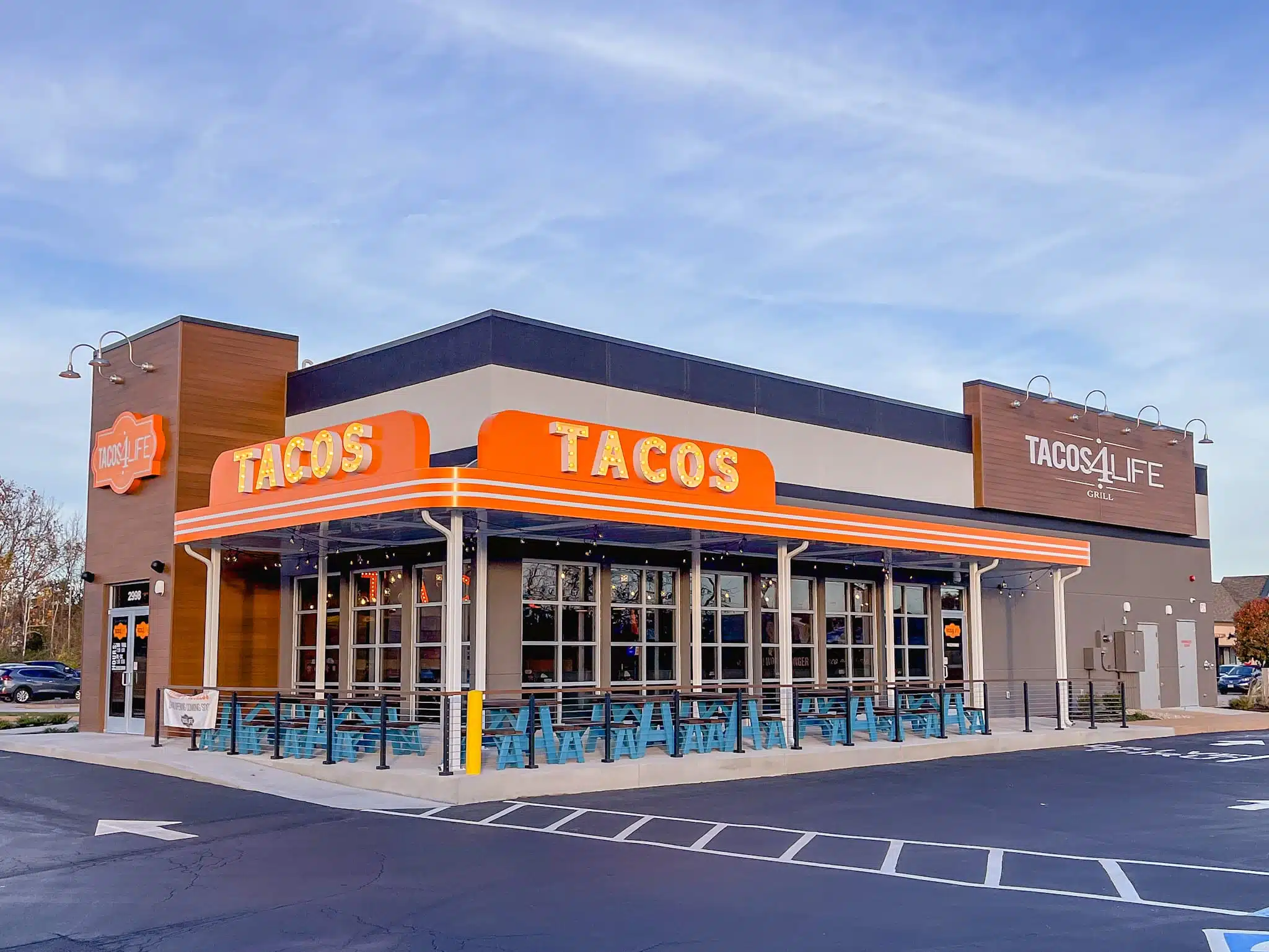
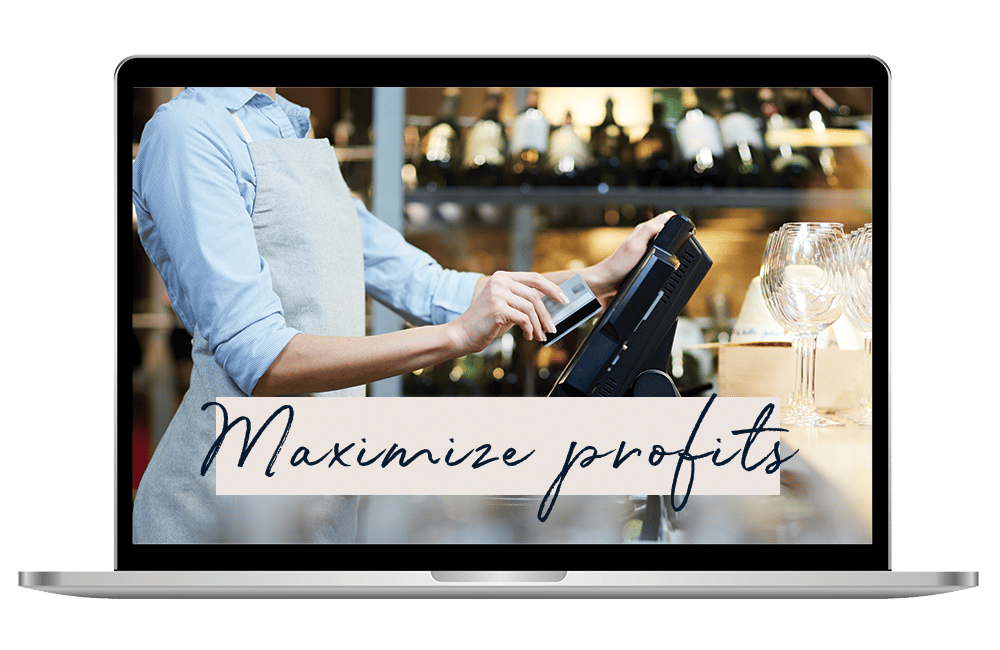
The three costly mistakes you could unknowingly be making?
Find out in this FREE guide and restaurant assessment specifically designed to reveal the unexpected hurdles standing between you and exponential business growth.
Thank You To Our Sponsors

Automate Your Sales Tax. Why Not Try Davo FREE for 30 Days.
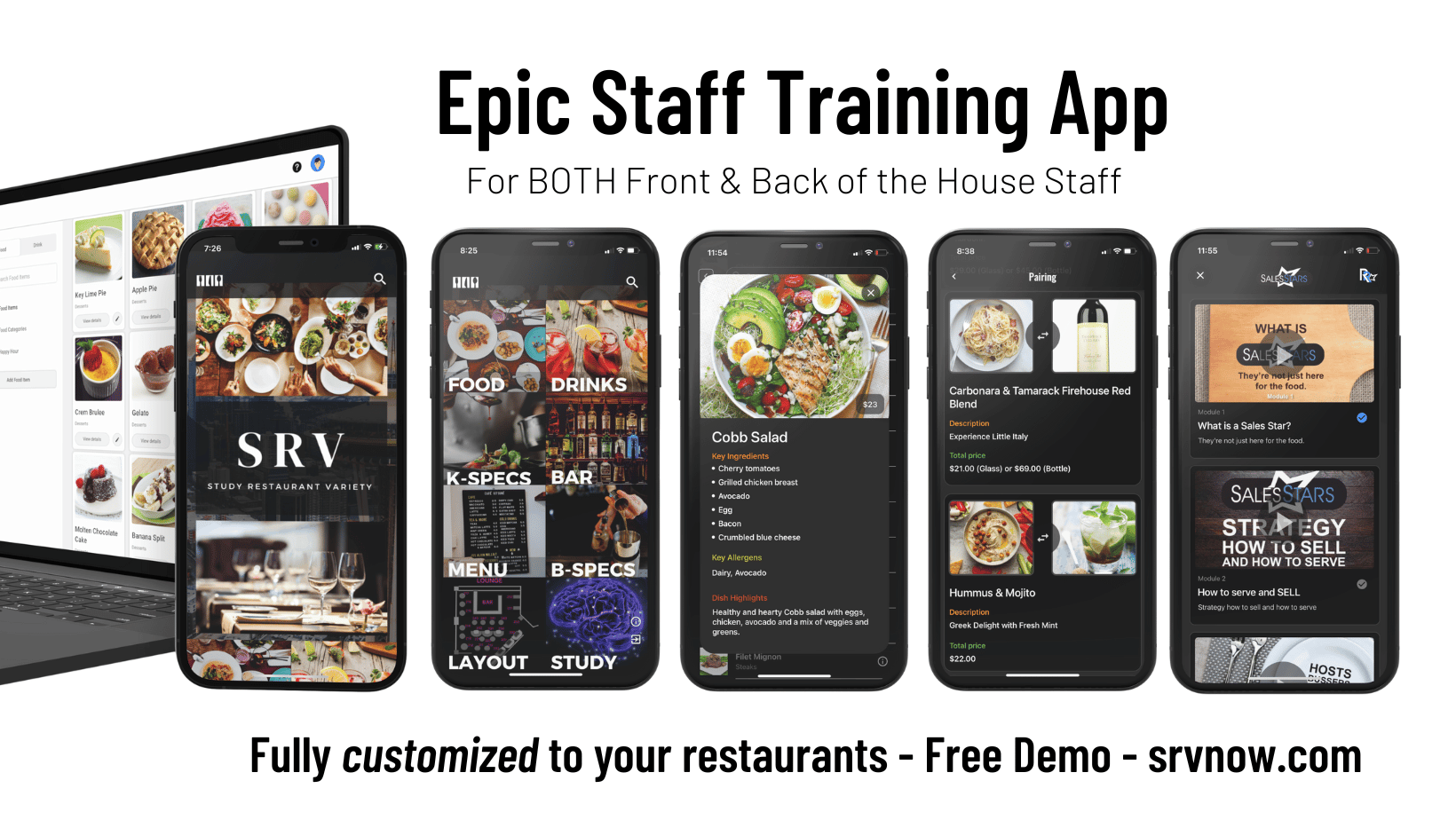
SRV teaches your team to profitably sell and accurately create the food and drinks at your restaurant.
Unlock Staff Potential and Maximize Sales
For a limited time only, popmenu is offering our listeners $100 off your first month plus an unchanging lifetime rate.
Request a DEMO:
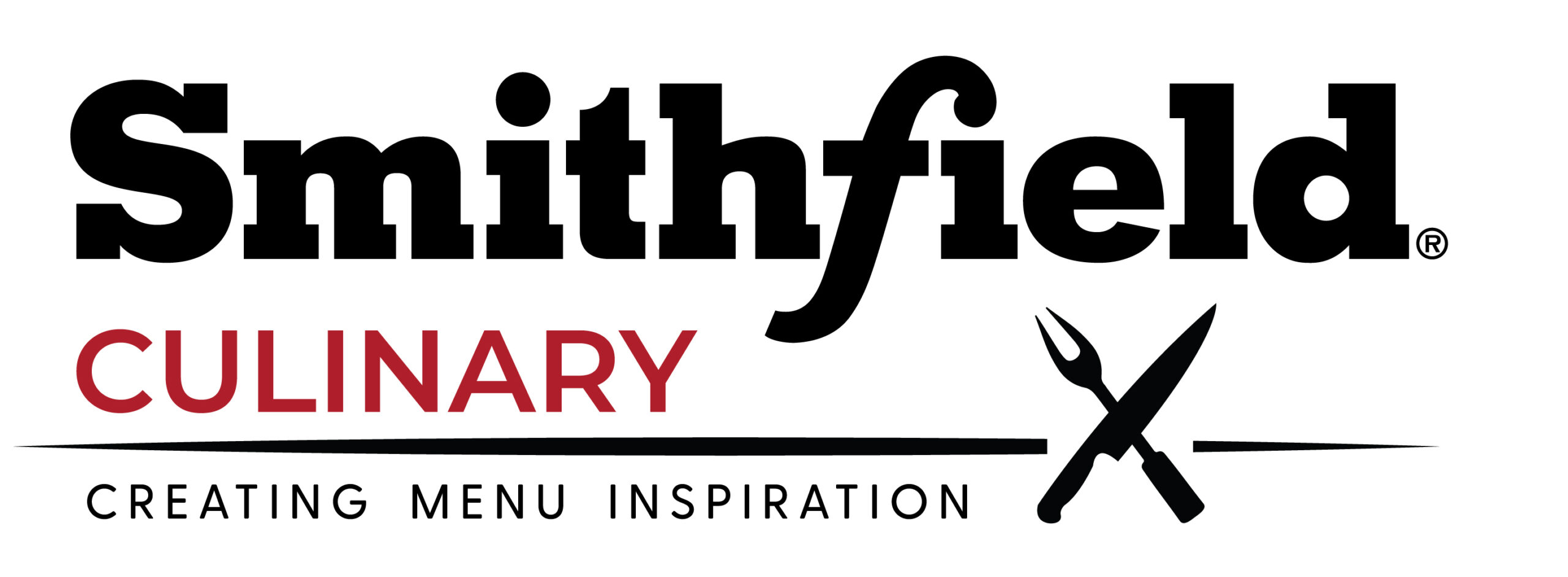
Inspiring Head-Turning Menu Creativity
Culinary Trends & Chef Inspired Recipes - Learn More
Want to become a podcast sponsor?
Please get in touch with Roger at roger@restaurantrockstars.com

